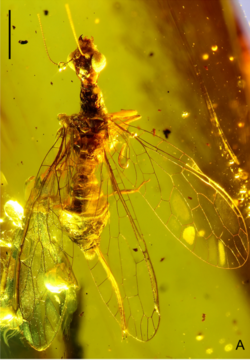Biology:Nanoraphidia
| Nanoraphidia | |
|---|---|

| |
| Nanoraphidia electroburmica female in Burmese amber | |
| Scientific classification | |
| Domain: | Eukaryota |
| Kingdom: | Animalia |
| Phylum: | Arthropoda |
| Class: | Insecta |
| Order: | Raphidioptera |
| Family: | †Mesoraphidiidae |
| Genus: | †Nanoraphidia Engel, 2002 |
| Type species | |
| Nanoraphidia electroburmica Engel, 2002
| |
| Species | |
| |
Nanoraphidia is an extinct genus of snakefly in the family Mesoraphidiidae containing the species Nanoraphidia electroburmica[1] and Nanoraphidia lithographica.[2]
The genus name is derived from a combination of the Greek nanos (dwarf) and the snakefly genus Raphidia, and the type species name from the Latin electrum (amber) and Burma, the former name of Myanmar.[1] The type species is known from the holotype, a single, partial adult, now deposited in the American Museum of Natural History as specimen number Bu-092.,[1] and several additional specimens.[3] The amber specimen is from deposits in Tanai Village, Kachin State 105 kilometres (65 mi) northwest of Myitkyina, Myanmar. The specimen has a badly disarticulated thorax and abdomen, which are present in the amber as integumental debris, however the head, wings, and anterior legs are in good condition.[1] Nanoraphidia electroburmica is the smallest known Raphidioptera species, living or extinct, the fore wings being only 4.2 millimetres (0.17 in) long.[1] The second species is named after the lithographic limestone of the La Pedrera de Rúbies Formation in Spain where it was found.
The genus is also the first to be described from a specimen of old world amber. Nanoraphidia is separatable from other Mesoraphidiidae genera by the small size of specimens and distinct vein structure of the wings.[1] The wings have an expanded costal area which is similar in appearance to the costal areas in Cretinocellia and Lugala. Both of these genera, however, belong to the Baissopteridae family and have many more crossveins and cells between Rs and M veins. The specimen shows N. electroburmica to have had a brown coloration to the body and a hyaline appearance to the wings.[1]
References
- ↑ 1.0 1.1 1.2 1.3 1.4 1.5 1.6 Engel, M.S. (2002). "The Smallest Snakefly (Raphidioptera: Mesoraphidiidae): A New Species in Cretaceous Amber from Myanmar, with a Catalog of Fossil Snakeflies". American Museum Novitates (3363): 1–22. doi:10.1206/0003-0082(2002)363<0001:TSSRMA>2.0.CO;2. https://www.biodiversitylibrary.org/bibliography/178494.
- ↑ Jepson, James E.; Ansorge, Jörg; Jarzembowski, Edmund A. (2011). "New snakeflies (Insecta: Raphidioptera) from the Lower Cretaceous of the UK, Spain and Brazil". Palaeontology 54 (2): 385–395. doi:10.1111/j.1475-4983.2011.01038.x. ISSN 0031-0239.
- ↑ Liu, X.; Lu, X.; Zhang, W. (2016). "New genera and species of the minute snakeflies (Raphidioptera: Mesoraphidiidae: Nanoraphidiini) from the mid Cretaceous of Myanmar". Zootaxa 4103 (4): 301–324. doi:10.11646/zootaxa.4103.4.1. PMID 27394738.
Wikidata ☰ Q6964122 entry
 |

